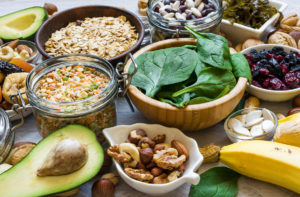Muscle relaxation is dependent upon the minerals magnesium and potassium. As I shared in my previous  blog post titled How to Stop Muscle Cramps at Night, it’s this combination of minerals that is key to preventing muscle cramps.
blog post titled How to Stop Muscle Cramps at Night, it’s this combination of minerals that is key to preventing muscle cramps.
Now before we look at natural sources it’s important to understand what your daily needs are for magnesium and potassium. According to the government the RDA (recommended daily allowance) for magnesium and potassium is:
Magnesium RDA for men is 400 mg per day
Magnesium RDA for women is 310 mg per day
Potassium RDA for adults is 4700 mg per day
And if you’re active, then the need for these two minerals increases.
Magnesium and Potassium – Good Food Sources for Magnesium
While potassium is needed for your muscle to relax you first need magnesium to facilitate the uptake of potassium into the muscle tissue. And it’s estimated that 80% of Americans are magnesium deficient. Given that men need 400 mg per day and women need 310 mg per day of magnesium here would be a good list of natural food sources to help you achieve these RDAs.
Spinach – 1 cup cooked provides 157 mg
Swiss Chard – 1 cup cooked provides 154 mg
Dark Chocolate – 1 square provides 95 mg
Pumpkin Seeds – 1/8 cup provides 92 mg
Almonds – 1 ounce provides 80 mg
Avocado – 1 medium size provides 58 mg
Figs – 1/2 cup provides 50 mg
Banana – 1 medium size provides 32 mg
Now I assume the one food source most people have zeroed in on is the dark chocolate. Just 3 squares per day would give you 285 mg of magnesium. But spinach and almonds are two other excellent sources that most people can consume on a daily basis to help them achieve the needed RDA.
Magnesium and Potassium – Good Food Sources for Potassium
The RDA for potassium is 4700 mg per day, which is significantly higher than magnesium. Most people associate bananas as their primary source for potassium. A medium size banana provides 487 mg of potassium or about 10 percent of your RDA. However, there are other natural food sources that have higher amounts of potassium. Here’s a list:
Sun-Dried Tomatoes – 1 cup provides 1800 mg
Avocado – 1 medium size provides 1067 mg
Swiss Chard – 1 cup steamed provides 961 mg
Acorn Squash – 1 cup provides 896 mg
Sweet Potato – 1 large size provides 855 mg
Spinach – 1 cup cooked provides 839 mg
Dried Apricots – 1/2 cup provides 756 mg
Tomato Sauce – 1 cup provides 728 mg
Wild Caught Salmon – 1/2 filet provides 722 mg
Red Potato – 1 medium size provides 695 mg
Pomegranate – 1 whole fruit provides 667 mg
Watermelon – 2 wedges provide 641 mg
Coconut Water (no added sugar) – 1 cup provides 600 mg
Butternut Squash – 1 cup provides 582 mg
Plain Yogurt – 1 cup provides 573 mg
Beets – 1 cup provides 518 mg
Canned Salmon – 5 oz can provides 487 mg which is the same as a large banana
That’s a nice list. When you combine it with the list for magnesium rich foods you can see that there are a couple of food choices that will help you maximize your efforts to consume good natural sources for magnesium and potassium.
They are: Spinach, Swiss Chard, Avocado, and Banana.
If you like pasta then make sure you add spinach to your pasta sauce to maximize your potential to get both magnesium and potassium into your system at the same time.
And while nutritional supplements are also a good avenue to pursue in making sure you’re getting enough magnesium and potassium, please try to get these two key minerals through the food you eat.
Leave a Reply
You must be logged in to post a comment.